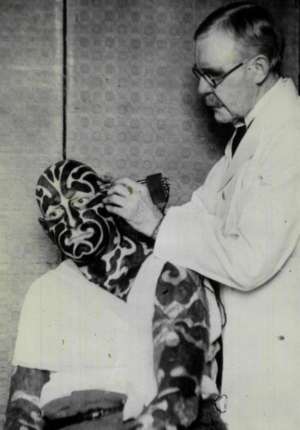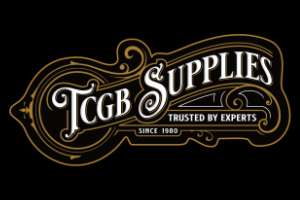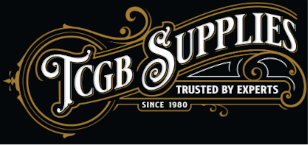
The Great Omi: A Tattooed Legend and the Mystery of His Life
Horace Ridler was born in the year 1882, into a world full of luxury and privilege. And attended some of the finest schools in Victoria England.
The Ridler family who were as upper class as one could get owned several horses in their well stocked stables. Which enabled young Horace to develop a strong passion for horse riding.
The families groom Joe Green who had once performed as a clown with the circus, would tell the young Horace many exciting stories of his past life on the road which not only fascinated the lad but planted a seed into the impressionable young Mr Ridler’s head. Green also taught Horace to ride and turned him into an accomplished horseman.
After leaving school and spurning the chance of a further education Ridler joined the army, which was met with his Fathers approval (who was himself of ex-military stock) and went in as a commissioned second Lieutenant. But before taking up his post Ridler did some travelling and visited much of Europe and North Africa. And it was in Africa that he came across many of the little bazaars that would take up so much of his time and where he would spend hours just watching the street entertainers, which reminded him of Green’s tales of the circus he had so enjoyed as a boy.
After his travelling days came to an end Horace returned to take up his position with the army, and it was around about this time when he suffered the blow of losing his Father. Who subsequently had left him a large inheritance. The young Ridler who had by now gained a care-free attitude to life did what most people would have done and went on a spending spree that not only saw him lose what was left to him, it also saw him getting into such financial trouble that he was forced to give up his army commission. Luckily though, he was able to save face and family honour by reenlisting back into the army at the start of the First World War in the August of 1914. This time joining a cavalry regiment and seeing battle in France and later to fight the German and Turkish armies with the ‘Dorset Mountain Corps’ – Gaining the rank of Major by the end of hostilities for gallantry.
So now with an army pension and bounty, Ridler invested in a chicken farm. Again he found that he just could not manage money and soon even this was gone and he was once again penniless. He was also finding (like some many Soldiers do) that life outside the army was hard. He also knew that he didn’t want to end up getting stuck in an office job, and went about looking for something different by again trying his luck abroad, although it wasn’t long before he was back on England’s shores looking for employment, alas with nothing or very little coming his way.
It was also around this time in 1920 that he once again started to recall many of Joe Greens circus stories. Prompting him into thinking about a life with the show folk, but what to do was another thing. He tried to gain work as a bareback horse rider and although he was a sound and very good horseman there were many others who were much better then him and had already secured places on the travelling show circuit.
He was also starting to get himself tattooed, knowing full well that people who turned themselves into human oddities were making large sums with many playing good money to see them. So in 1922 he decided that he would turn himself into a tattoo attraction by getting tattooed form head to foot.
The tattooist who was tattooing Horace at the time was later disregarded as even Horace (who was not a tattooing expert) could see that he was not up to the job of doing the sort of work he needed doing upon himself to gain fame. And after having quite a few crudely done tattoos on his arms Horace sought to find someone who could do a much better job and to tattoo his entire body including his face.
Surprisingly though, he came up against tattoo artists who would not consider tattooing the face (the body was fine but not the face) and he very nearly gave up, and indeed he did for a while until he found that Brighton born London tattoo artist George Burchett of 72 Waterloo Road, Lambeth would be prepared to do the tattooing as long as he had it written down in the form of a letter relieving him of any blame after the tattooing was completed (as even Burchett was concerned that Ridler might regret having his face tattooed at a later date).
Horace undertook this and a letter dated the 24th of May 1934 was sent to confirm his wish. Horace was now married to Gladys and she also signed this letter agreeing to the tattooing of her husband. So with George Burchett being somewhat of a last resort, the tattooing started at a rate of two-hour sittings three times a week.
The Ridlers who were living at 21 Raleigh Gardens in Mitcham, Surrey at the time, would travel to Waterloo together each week and after one hundred and fifty hours of tattooing Horace Ridler was transform into the tattooed man.
The stage name of ‘The Great Omi’ is believed to have come via Horace having read about Omai the tattooed man Captain Cook came across and had Tobias Furneaux take back to England on the ‘Adventure’ in 1774, and by dropping the a in Omai he became Omi.
But it wasn’t just the tattooing that Gladys and Horace had to put up with, for in the early to mid twentieth century the tattooing procedure was a lot hasher then it is today and Horace had to spend many hours and even days in bed waiting for the swelling’s (with many becoming infected) to go down. The tattooing (to be paid in instalments) cost Ridlier £100.00 pounds, which was a small fortune back then.
He did not and needn’t have worried though for his new look certainly paid off as shortly after the tattooing was finished he got his first well-paid job with the ‘Bertram Mills Circus’ at the London ‘Olympia’. In fact he toured all over Britain with ‘Bertram Mills’ with thousands of people wanting to see the world’s most tattooed man. Sadly for Ridler and after becoming such a sensation with ‘Bertram Mills’ he received hardly any more bookings and undertook a tour with a traveling French circus that turned into the tour from hell. And in a letter sent to Burchett from the Omi upon his return to England (dated September 1st 1935) told of the terrible conditions he had to work under and of how he had been greatly deceived by the shows organisers – who not only billed him as a new form of animal he had to perform next to a lions cage without a divider or curtain to change behind – He was also a foreigner who spoke no French with a troop who spoke no English and also had to travel from town to town after each show without so much as a break or day off for the three months he managed to stick it out for.
He even had to pay his own way – so the wages he did earn went on food and accommodation for himself and Gladys – He also became sick and his employers were none to happy with him when one Sunday the Omi could take no more and took the day off to visit the local doctor – who after tests told him that he was suffering from a form of gas poisoning which was caused by the urine in the lions cage that he had to work beside.
And it was this and the fact that his billing said that he wasn’t human at all – but an animal-man who wasn’t even tattooed or dyed – stating that his body markings were natural – prompted him to leave the tour and return to England – as even the paying public could see that this was a lie and took it out on him by jeering at every opportunity possible.
On his return to England he decided to undergo more extreme treatments to give himself a more barbaric look and in an interview he told of how – ‘I had my nose pierced by a veterinarian so I could insert different kinds of ivory tusks. My ear lobes were pierced and stretched until the holes were each about the size of a dollar piece. Of course I went to a regular dentist to have my teeth filed down into sharp points – and I also bought highly coloured clothes and wore long golden boots’
In 1939 things really took off for the Omi and his wife when they travelled to the United States on HMS Laconia (arriving on June the 6th 1939) Staying at the ‘Hotel Claridge’ in Times Square where the Omi became an attraction at the world’s fair which was held at Queens, New York from April the 30th to October 31st 1939 – billed as the ‘World Of Tomorrow’ – It was also at this fair that the Omi made his first television appearance (Possibly his only ever TV appearance). He also made the newspapers of New York City when it was reported that the Omi and his wife were attacked when they were sightseeing in ‘Times Square’ and he received cuts on his chin and cheek by an unknown attacker. But as there are no photographs or police reports of this incident recorded the alleged attack was probably a publicity stunt, which could well have been the case, as the ‘World Fair’ drew over 20 million visitors who not only saw the Omi and many other fascinating things – the public also got to see the ‘Tattoo Venus’ Betty Broadbent (who appeared with the Omi at the John Hix’s odditorium) all for the princely sum of 40 cents a pop.
After the fair came to an end the Omi joined the ‘Ripley’s Believe It Or Not’ show at Ripley’s auditorium – where he had a very lucrative time touring Broadway and the like – and having the longest run of any showman ever employed by Robert Leroy Ripley (appearing well over a thousand times in the six months he worked for the showman).
He also went on to join the ‘Ringling Brothers’ sideshow for one season before joining probably the world’s most famous circus ‘Barnum and Bailey’.
1940 also saw the Omi and his wife travelling to Canada to work at a theatre in Calgary – before returning to the United States to do shows to packed houses and earning a fortune. With many believing that the Omi was at one time the world’s highest paid showman. And even-though he was earning large sums of money; he couldn’t get over the fact that the Second World War was raging in Europe. So he decided he would re-enlist in the army and go home and fight. This proved unsuccessful and he was told by the British Consulate in New York that he was too old and would not be required. So with this bad news he and Gladys went back to Canada to entertain the troops. He even became ‘Twentieth Century Fox’s’ main attraction and toured all of the Fox cinemas, and in 1941 the Omi and his wife left Canada and toured Australia and New Zealand before returning to Vancouver to join ‘The Happyland Sideshow’ – but he wasn’t happy there – so he joined Bert Lorous ‘World Of Freaks’ from August the 25th to September the 9th 1941 – before leaving to join the ‘Rubin-Cherry sideshow’ in San Diego.
He also throughout his career sold postcards of himself for 20 cents a throw. But with this and all the countries he was visiting didn’t detract from the fact that his own county was at war and the couple later left to return to England to once again entertain the troops as well as working for charity until the end of the war.
After the Second World War, Omi did return to the stage with the ‘Bellevue Circus’ in Manchester with Gladys as his compare calling herself Omette – becoming even more popular then before, and at the height of their fame in the early 1950’s the pair decided to retire and to live out the rest of their life’s at the ‘Golden Cross Caravan Park’ just outside Hailsham in East Sussex, England.
The Interesting thing that has been said by the many people who ever met or saw the ‘Great Omi’ – was that he was indeed a true gentleman and that he was a very big man – In fact he was over six foot four inches tall – The late Ron Ackers recalled (in a taped interview) that he saw the Omi once in Brighton and was amazed by the whiteness of his skin (that made his black tattooing marks stand right out) as well as the size of him and how awesome he looked.
In the last ever recorded interview the Omi gave – his last words were ‘Underneath it all, I’m really an ordinary man,’
Horace Ridler, died in 1965 aged 83 – Gladys passed away from breast cancer in 1969. And one would have thought that would have been the end of the story – but it’s been far from – as today the ‘Great Omi’s likeness is seen on everything in the tattooing world – from ceramics to t-shirts, business cards, postcards and in various tattooing publications, dolls and books – there has even been a fifteen minute film about the life of Horace Ridler shown on Britain’s Channel Four Television – Where the start of the short film had a young Horace (played by the actor Duncan Bell) going through some old boxes and coming across a photograph of himself with a dead (shot) Zebra, before cutting to a scene where he is sitting on a train looking at the very picture, before a voice over went on to tell us the story of ‘The Great Omi’ who also at one time went by the name ‘The Zebra Man’ (hence the photograph). The actress who played the ‘Omi’s’ wife Gladys, was the not so famous (at the time) Minnie Driver – who for some reason was called Emily Ashdown in this production, with Peter Guinness playing George Burchett. There were two other actors in this and they were Garard Green and Matthew Byam-Shaw. Written and directed by Tom Hare Duke and Peter Webber and produced by Jane Caldwell. Tattoo artist Lal Hardy supplied the tattooing equipment and helped in the production, and he was not given credit for doing so.
Copyright…Paul Sayce. Posted 5th March 2010


